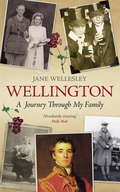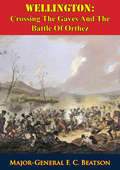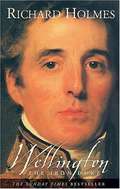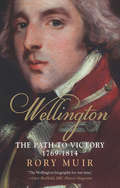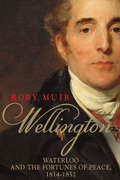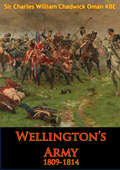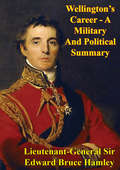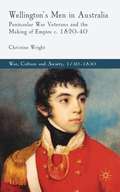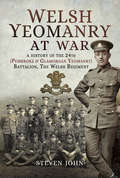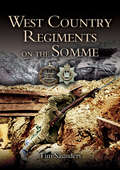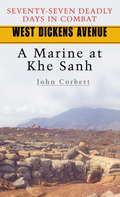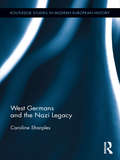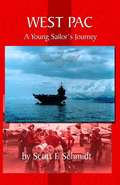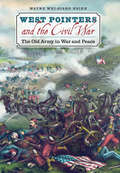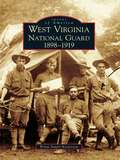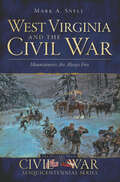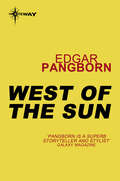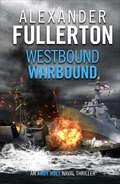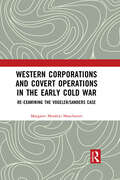- Table View
- List View
Wellington: A Journey Through My Family
by Jane WellesleyJane Wellesley is privileged to be a part of the Wellington legacy. Her father, the eighth Duke of Wellington, was born in 1915; a hundred years after the first Duke's great victory over Napoleon at Waterloo. The Wellington legacy ranges from the triumphant to the trivial, and the Duke of Wellington remains the most celebrated of all British generals. When he died, Queen Victoria wept with the nation, mourning the loss of 'the greatest man England has known.' A million and a half people swarmed London streets to watch his cortege pass on its way to St Paul's. Few facts can be added about the public man. But Jane isn't an historian: this memoir is intended to see him as husband and father, as brother and several degrees of grandfather. It is a highly personal account; selective and anecdotal. Informed by a female sensibility, it weaves together characters and places, establishes connections, and explores 'footnotes' such as the Wellington women. Jane visits the battlefield of Waterloo with her father to set this tale in motion - her father features heavily alongside the great first Duke, and Dukes 2 through 7 are encompassed to complete an amazing portrait. This is a sparkling journey of enlightenment; a family tree exposition that puts historic analysis firmly in the shade.
Wellington: A Journey Through My Family
by Lady Jane WellesleyA highly personal, anecdotal family memoir of the Wellington legacy.Jane Wellesley is a member of one of Britain's most illustrious families. Her father, the 8th Duke of Wellington, was born in 1915, a hundred years after the first Duke's momentous victory over Napoleon at Waterloo, but only a little over sixty years after the death of his celebrated ancestor. When the 'Iron Duke' died Queen Victoria wept with the nation, mourning the loss of 'the greatest man England has known'. A million and a half people swarmed London's streets to watch his cortege pass on its way to St Paul's. Few facts can now be added about the public man, but Jane's family memoir animates the First Duke as husband and father, as brother and several degrees of grandfather. Her journey through this richly compelling family history begins and ends with the first Duke, visiting the battlefield of Waterloo with her father to set her fascinating tale in motion. Through her parents she reaches back to earlier generations, weaving together characters and places, establishing connections, and exploring in greater depth than usual the Wellington women, who are often reduced to footnotes in conventional histories. She unearths memories, visits places from her parents' past, and discovers much about the lives of her grandparents and the generations before them. Most of us view the First Duke of Wellington as an iconic figure, whose name has been claimed by pubs, squares, streets, and, of course, rubber boots. In this highly personal account, the public man gives way to the private, and Wellington's legacy is seen through the eyes of those who have followed in his footsteps. Jane Wellesley triumphantly succeeds in wresting the Duke from his lonely column to reclaim him for his family, and so for the reader.
Wellington: Crossing The Gaves And The Battle Of Orthez
by Major-General F. C. BeatsonIN this book an attempt is made to show how the greatest of modern British Generals planned and carried out the first stages in the execution of the task set him by his Government, namely, to make a further advance into French territory, and thereby render efficient co-operation to the armies of the other Great Powers then about to invade Northern and Eastern France.The distance between the two spheres of action was too great to permit the hope of active co-operation between the armies under Wellington and those of Austria, Prussia and Russia. This Wellington recognized, though it does not appear to have been so clearly realized at the headquarters of the allied sovereigns. The co-operation had to be indirect and be worked by preventing Napoleon from calling to himself the large force of veteran soldiers he still had in the south, by pushing back those opposed to the allied armies under Wellington, and so bringing under the latter's control a large and wealthy area of Southern France, thereby lessening the Emperor's prestige and imposing on him the loss of considerable resources in men and money, and opening also a field for action against him by the supporters of the Bourbon party.But for Colonel Henderson's untimely death we should now have a real military life of Wellington. This is not an attempt in any way to fill the gap: but merely to give an example of how that general applied his strategical skill with a highly perfected machine.--Preface.
Wellington: The Iron Duke
by Richard HolmesIn this compelling biography, Richard Holmes charts the life of the Duke of Wellington, Britain's greatest soldier. He follows Wellington's remarkable career, from the ruins of his family seat in Ireland and the plains of India where he first gained his reputation as a brilliant commander, to the horrors of the Peninsular War and Waterloo. Holmes sees Wellington as a brilliant figure, idealistic in politics, War and Waterloo. Holmes sees Wellington as a brilliant figure, idealistic in politics, cynical in love, a man of enormous courage and iron duty often sickened by the horrors of war.
Wellington: The Path to Victory, 1769–1814
by Rory MuirThe leading Wellington historian&’s fascinating reassessment of the Iron Duke&’s most famous victory and his role in the turbulent politics after Waterloo. For Arthur Wellesley, First Duke of Wellington, his momentous victory over Napoleon was the culminating point of a brilliant military career. Yet Wellington&’s achievements were far from over: he commanded the allied army of occupation in France to the end of 1818, returned home to a seat in Lord Liverpool&’s cabinet, and became prime minister in 1828. He later served as a senior minister in Peel&’s government and remained commander-in-chief of the army for a decade until his death in 1852. In this richly detailed work, the second and concluding volume of Rory Muir&’s definitive biography, the author offers a substantial reassessment of Wellington&’s significance as a politician and a nuanced view of the private man behind the legend of the selfless hero. Muir presents new insights into Wellington&’s determination to keep peace at home and abroad, achieved by maintaining good relations with the Continental powers and resisting radical agitation while granting political equality to the Catholics in Ireland rather than risk civil war. And countering one-dimensional pictures of Wellington as a national hero, Muir paints a portrait of a well-rounded man whose austere demeanor on the public stage belied his entertaining, gossipy, generous, and unpretentious private self.&“[An] authoritative and enjoyable conclusion to a two-part biography.&” —Lawrence James, Times (London)&“Muir conveys the military, political, social and personal sides of Wellington&’s career with equal brilliance. This will be the leading work on the subject for decades.&” —Andrew Roberts, author of Napoleon and Wellington: The Long Duel
Wellington: The Story Of A Scottish Soldier And Statesman, Wellington's Quartermaster General (From Reason To Revolution Ser. #114)
by Rory MuirThe preeminent Wellington biographer presents a fascinating reassessment of the Duke&’s most famous victory and his political career after Waterloo. The Duke of Wellington&’s momentous victory over Napoleon at the Battle of Waterloo was the culminating point of a brilliant military career. Yet Wellington&’s achievements were far from over. He commanded the allied army of occupation in France to the end of 1818, returned home to a seat in Lord Liverpool&’s cabinet, and became prime minister in 1828. He later served as a senior minister in Robert Peel&’s government and remained Commander-in-Chief of the Army for a decade until his death in 1852. In this richly detailed work, the second and concluding volume of Rory Muir&’s definitive biography, the author offers a substantial reassessment of Wellington&’s significance as a politician and a nuanced view of the private man behind the legendary hero. Muir presents new insights into Wellington&’s determination to keep peace at home and abroad, achieved by maintaining good relations with the Continental powers, resisting radical agitation, and granting political equality to the Catholics in Ireland. Countering one-dimensional image of Wellington as a national hero, Muir paints a nuanced portrait of a man whose austere public demeanor belied his entertaining, gossipy, generous, and unpretentious private self.
Wellington: pocket GIANTS
by Gary SheffieldWellington is a giant because he was one of the greatest military commanders in British history, an important figure in the emergence of Britain as a great imperial power, a man who dominated British society and politics for 35 years. He was the only one of Napoleon’s contemporaries who can be mentioned in the same breath as a general - a master of logistics, politics and coalition warfare as well as strategy, operations and tactics. The book’s focus is on Wellington’s military career, and it looks at all of these aspects, placing them in the context of the military and political developments of the time. It explores Wellington’s personality – a key to understanding his success - and briefly examines his post-Waterloo career as a politician. It concludes that Wellington was not only a military genius, but an icon whose fame endures to our own time.
Wellington’s Army 1809-1814 [Illustrated Edition]
by Sir Charles William Chadwick Oman KbeIncludes over 100 maps of the actions, engagements and battles of the entire Peninsular War.Whilst writing his magisterial The History of The Peninsular War, Sir Charles Oman gathered material that was to become Wellington's Army. Into Wellington's Army he gathered, as he says in his Preface, "much miscellaneous information which does not bear upon the actual chronicle of events in the various campaigns that lie between 1808 and 1814, but yet possesses high interest in itself, and throws many a side-light on the general course of the war ... these notes relate either to the personal characteristics of that famous old army of Wellington, which, as he himself said, 'could go anywhere and do anything,' or to its inner mechanism -- the details of its management. I purport to speak in these pages of the leaders and the led; of the daily life, manners, and customs of the Peninsular Army, as much as of its composition and its organization. I shall be dealing with the rank and file no less than with the officers, and must even find space for a few pages on that curious and polyglot horde of camp followers which trailed at the heels of the army, and frequently raised problems which worried not only colonels and adjutants, but even the Great Duke himself."
Wellington’s Career - A Military And Political Summary
by Lieutenant-General Sir Edward Bruce HamleyNUMEROUS excellent works descriptive of Wellington's military exploits have been given to the public, and the inquirer who seeks information on any particular phase of his career need be at no loss for ample materials on which to ground an opinion. But it is scarcely possible that works which afford these necessary and invaluable details should also present to the reader's clear outline of the subject in all its Unity and simplicity. Lost in the mazes of the scene of campaign or the theatre of war, he fails to recognise, in the devious movements and shifting plans, the evidence of a presiding and controlling spirit; and it is not till, with much labour, he has succeeded in massing the minor incidents round their true centres that he perceives the full scope and meaning of each series of operations with reference to the main design; that, as a general reader, he can appreciate the grandeur of the mind which conceived and evolved them; and that, as a military student, he can profitably seek in them for illustrations of the great principles of war.
Wellington’s Lieutenants [Illustrated Edition]
by Alexander Innes ShandIncludes over 100 maps of the actions, engagements and battles of the entire Peninsular War."The men who stood beside the Great DukeThe Duke of Wellington was indisputably one of the most able military commanders in British history. He was not only a powerful intellect, but also a man of substantial character...To Wellington, delegation failed to come easily...He insisted on a knowledge of all things that might concern him and was prepared to issue directives on all matters. It is then, unsurprising that he eclipsed his immediate subordinates, senior figures and highly respected commanders in their own right, who were often given little latitude, and were regularly not fully briefed as to Wellington's strategy and grand tactics; for example, at Waterloo, amid flying shot, the duke terrified his staff by appearing to be the only person in possession of the plan of battle. All this, however, does nothing to diminish the clear contribution many of those closest to the Great Duke made towards the success of his campaigns. While having lessons to learn from Wellington they were more than capable military men-if not actually possessed of quite the same degree of military 'genius' as their commander in chief. This book chronicles eight of Wellington's lieutenants as they fought for him in the Peninsula and at Waterloo. Lord 'Daddy' Hill earned his nickname because of his extraordinary concern for the well-being of his soldiers; he was Wellington's most trusted general and was, unusually, given independent command by Wellington. The fiery Craufurd, leader of the Light Division, could always be depended upon to take the fight to the enemy-sometimes whether it was prudent to do so or not. Picton, the hard swearing Welshman...Accounts of the campaigns and actions of these notable soldiers are joined in this riveting book by those of Beresford, Lynedoch, Hopetoun, Anglesey and Combermere."-Print ed.
Wellington’s Men in Australia
by Christine WrightAn exploration of the little-known yet historically important emigration of British army officers to the Australian colonies in the aftermath of the Napoleonic Wars. The book looks at the significant impact they made at a time of great colonial expansion, particularly in new south Wales with its transition from a convict colony to a free society.
Wellington’s Peninsular Victories: Busaco, Salamanca, Vitoria, Nivelle (Great Battles Ser.)
by Michael GloverFirst published in 1963, this book concentrates on four great military victories of the Peninsular War (1807-1814): the Battle of Busaco of September 27, 1810; the Battle of Salamanca of July 22, 1812; the Battle of Vitoria of June 21, 1913; and the Battle of Nivelle of November 10, 1913.Richly illustrates throughout with photos, maps and plans.“You have sent me...the staff of a French Marshal, and I send you in return that of England.”—HRH The Prince Regent to Viscount Wellington after Vitoria“A lucid and absorbing account of the five years of arduous campaigning that brought the Allies to Toulouse in April, 1814...quotes freely from many fascinating eyewitness descriptions”—The Soldier“Concentrates attention on four of Wellington’s greatest triumphs—Busaco, Salamanca, Vitoria, and the Nivelle...which routed the finest soldiery in Europe and sent four of its most famous Marshals cringing back to Napoleon in disgrace”—The Daily Telegraph“Michael Glover’s book is a brilliant success, like the campaign which inspired it”—The Times Literary Supplement
Welsh Yeomanry at War: A History of the 24th (Pembroke & Glamorgan Yeomanry) Battalion, The Welsh Regiment
by Steven JohnSoon after the outbreak of the Great War, following many years of part-time soldiering as cavalry troops on home defense duties, the members of various British Yeomanry regiments were asked to volunteer for overseas service. In 1916, officered by well-known members of the landed gentry, two of the Welsh Yeomanry regiments, the Pembroke Yeomanry and the Glamorgan Yeomanry, were amongst many who embarked for foreign service for the first time ever in their history. Spending the next twelve months in Egypt during the campaign against the Senussi tribesmen, the two regiments merged to form the 24th (Pembroke and Glamorgan Yeomanry) Battalion, Welsh Regiment, which joined the 74th (Yeomanry) Division to take part in the historic offensive into Palestine that ultimately led to the liberation of the Holy City of Jerusalem after 400 years of Ottoman rule. In May 1918, after two years of hard campaigning in the Palestinian deserts, the 24th Welsh embarked for France with the rest of the 74th Division, joining the Allied forces in the victorious 100-day offensive against the Germans. Welsh Yeomanry at War sheds new light on the battalions almost forgotten campaign in Palestine, which saw many of its troops killed and buried in the Holy Land, and also tells the enthralling story of its short but arduous period in France.
Went the Day Well?: Witnessing Waterloo
by David CraneMidnight, Sunday, June 18, 1815. Britain holds its breath. Since Napoleon's escape from Elba in February, Europe has been jolted from eleven months of peace back into the frenzied panic of a war it believed had ended. "The whole complexion of the world is changed again," writes George Ticknor, then a young American lawyer in Britain for the first time. "God only can forsee the consequences." The nation is awash in reports and rumors. The Battle of Waterloo is close at hand. Went the Day Well? is an astonishing hour-by-hour chronicle that starts the day before the battle that reset the course of world history and continues to its aftermath. Switching perspectives between Britain and Belgium, prison and palace, poet and pauper, lover and betrothed, husband and wife, David Crane paints a picture of Britain as it was that summer when everything changed. Drawing on a wide range of primary sources--from newspapers and journals to letters and poems--Went the Day Well? offers a highly original view of Waterloo, grand in scope but meticulous in detail. What was Britain doing on that Sunday, from the mad king downward? Who were born to live out their lives in the Britain created at Waterloo? Who died? Who was preaching, who was writing and who was painting? Lyrically rendered in Crane's signature prose style, Went the Day Well? freeze-frames the men and women of Britain in 1815 as they went about their business, attended lectures, worked in fields and factories--all on the cusp of a new, unforeseeable age.From the Hardcover edition.
West Country Regiments on the Somme
by Tim SaundersPrevious works have concentrated on the 'Pal' in Britain's northern towns and cities. This book seeks to explore the little appreciated part in the Battle of the Somme played by the Regular and Volunteer Service battalions of two small West Country regiments; the Devonshire Regiment and the Dorset Regiment. These two regiments had five battalions in action on the first day of the battle and were represented in most of the significant attacks during the three and half months of the 1916. The reader will be able to form a clear picture of the battle's development as a whole through the eyes of Westcountry soldiers who fought on the Somme.
West Dickens Avenue: A Marine at Khe Sanh
by John CorbettIn January 1968, the 26th Marine Regiment was ordered to a place in the far northwest corner of South Vietnam called Khe Sanh. John Corbett, an untested replacement in a clean, green uniform, and his fellow leathernecks were responsible for building and defending the combat base, and holding positions on the strategic hills overlooking the Ho Chi Minh Trail as it crossed into Laos and South Vietnam from nearby North Vietnam. Only days after Corbett arrived at Khe Sanh, some twenty thousand North Vietnamese soldiers surrounded the base, outnumbering the American Marines seven to one. What followed over the next seventy-seven days became one of the deadliest fights of the Vietnam War--and one of the greatest battles in military history. Private First Class Corbett, an "ammo humper" in an 81mm mortar section, made do with little or no sleep for days on end. The enemy bombarded the base incessantly, and Corbett's mortars returned the fire, day and night. Extremes of heat, cold, and fog added to the misery, as did all manner of wounds and injuries too minor to justify evacuation from frontline positions. The emotional toll was tremendous as the Marines saw their friends suffer and die every day of the siege. Corbett relates these experiences through the eyes of an eighteen year old but with the mind and maturity of a man now in his fifties. His story of life, death, and growing up on the front lines at Khe Sanh speaks for all of the Marines caught up intheepic siege of the Vietnam War.
West Germans and the Nazi Legacy (Routledge Studies in Modern European History)
by Caroline SharplesThis book constitutes a new history of the complex memory cultures that persisted within post-war West Germany, examining the attitudes of ordinary people to the second wave of Nazi war crimes trials ushered in during the 1960s. It explores responses to the prospect of continuing investigations, the reception afforded to the defendants, and the sheer resonance that such proceedings could generate within a local community. Drawing upon case studies from across the Federal Republic, it bridges a gap between the current historiography and localised memory studies, and analyses of war crimes trials. Far from viewing the 1960s as an uncomplicated decade of change, this book emphasises the range of voices that were competing to make themselves heard during this period, whether they came from survivors’ groups, crusading journalists and students, or from former prisoners of war, veterans’ organisations and the war widowed. This diversity of opinion and experience enabled the persistence of silences, distortions and mythologies that could afford some level of distance to be imposed between the perpetrators of the Nazi genocide, and the ordinary West German population. The process of ‘coming to terms with the past’ was thus complicated and protracted.
West Pac
by Scott SchmidtWhen a carrier goes to sea, those who work on the dangerous flight deck are at an average age of twenty years old. To add to the danger, those who work with aircraft ordnance, the bombs and missiles of these planes, are at even more risk of injury on the pitching deck. This is a true story of one young man, an aviation ordnanceman, who went to sea on his second cruise in 1978 at age twenty. What he discovered in the hot Pacific and Indian Oceans would change his life forever and set him on a path to discovery. Follow the author on his personal and poignant journey as he explores the universal truths of those who must succeed under arduous conditions.
West Point Warriors: Profiles of Duty, Honor, and Country In Battle
by Tom CarhartWhen America must be defended, the men of West Point are there. From the War of 1812 to the twenty-first-century fight against terrorism at home and abroad, in the heat of battle and in the face of certain death, they give ever-renewed meaning to the West Point motto, "Duty, Honor, Country." They range from the celebrated, like Robert E. Lee and Douglas MacArthur, to the unsung, including Patrick H. O'Rorke, who stunned the Confederates at Little Round Top with a ferocious and gallant charge that stopped their advance; Russell P. Reeder, Jr., who led his regiment ashore at Normandy and valiantly fought German forces before losing a leg; and Joseph G. Clemons, Jr., who commanded an infantry company that held off the enemy on Pork Chop Hill in Korea. They -- and many more -- were all West Point warriors, men who led America's soldiers through this nation's wars and who protect us to this day with selfless sacrifice and unbounded bravery. Book jacket.
West Pointers and the Civil War: The Old Army in War and Peace
by Wayne Wei-siang HsiehMost Civil War generals were graduates of West Point, and many of them helped transform the U. S. Army from what was little better than an armed mob that performed poorly during the War of 1812 into the competent fighting force that won the Mexican War. Wayne Wei-siang Hsieh demonstrates how the "old army" transformed itself into a professional military force after 1814, and, more important, how "old army" methods profoundly shaped the conduct of the Civil War.
West Virginia National Guard: 1898-1919 (Images of America)
by Brian Stuart KestersonThe formation of what would eventually become the West Virginia National Guard has its roots intertwined in the "Old" Virginia Militia system of the early and mid-1700s. This militia system spanned the Indian hostilities of the French and Indian War, American Revolutionary War, 1780s and 1790s Indian Wars, and Civil War. Images of America: West Virginia National Guard covers the time span between 1898 and 1919. This period of guard history was chaotic, to say the least, and was typified by turbulent social, economic, and political unrest.
West Virginia and the Civil War: Mountaineers Are Always Free (Civil War Sesquicentennial Series)
by Mark A SnellA comprehensive account of the state&’s creation, its citizens, and their contributions to the war effort—whether supporters of the Union or Confederacy. The only state born as a result of the Civil War, West Virginia was the most divided state in the nation. About forty thousand of its residents served in the combatant forces about twenty thousand on each side. The Mountain State also saw its fair share of battles, skirmishes, raids and guerrilla warfare, with places like Harpers Ferry, Philippi and Rich Mountain becoming household names in 1861. When the Commonwealth of Virginia seceded from the Union on April 17, 1861, leaders primarily from the northwestern region of the state began the political process that eventually led to the creation of West Virginia on June 20, 1863. Renowned Civil War historian Mark A. Snell has written the first thorough history of these West Virginians and their civil war in more than fifty years.
West of the Sun
by Edgar PangbornSeveral light-years west of the Earth's Sun lay the planet, Lucifer, circling a sun of its own, circled by its own two moons. The five specially selected and trained passengers of the "Argo" found much on Lucifer to remind them of the Earth they had left eleven years before. The air was invigorating, the vegetation lush, and there were people - a race of friendly white giants and a swarming population of wary pygmy tribes. The Earth pioneers soon faced the problem of survival on the red-green planet, and also the founding of a democratic civilization among the strife-torn pygmies. However, they were soon entwined in a brutal war between opposing pygmy forces. On the outcome of this war hinged the very fate of the new way of life on Lucifer...
Westbound, Warbound (The Andy Holt Naval Thrillers)
by Alexander FullertonThe first in the gripping historical Andy Holt Naval Thrillers series.Andy Holt is third mate on the cargo ship PollyAnna, carrying coal through Nazi-infested waters. Holt's vessel is bound for Montevideo, all the while wary of a particular German warship, the Graf Spee, which is picking off British vessels.But as the PollyAnna leaves Montevideo, the Graf Spee shows up in the same port holding British prisoners. It seems the crew of the PollyAnna will need to take matters into their own hands. Alongside his shipmates, Holt must perform a daring rescue, one that could cost them their lives…Westbound, Warbound is Fullerton on top form – a gripping historical thriller perfect for fans of Douglas Reeman and Philip McCutchan.
Western Corporations and Covert Operations in the early Cold War: Re-examining the Vogeler/Sanders Case
by Margaret Murányi ManchesterThis book examines the Vogeler/Sanders espionage case that ruptured ties between the US and UK and Hungary in 1949, and analyses this as an example of Western covert operations in the early Cold War. The work focuses on the 1949 case of ITT in Hungary, where two of its executives, the American Robert A. Vogeler and the Briton Edgar Sanders, were arrested by the secret police, tortured, forced to confess, put on a public show trial, and found guilty of espionage. This happened at a time that the US and the UK were cooperating in numerous operations to undermine the credibility of the communist regime and to encourage local resistance by “all means short of war.” Using the case as a lens to examine the dynamics of the early Cold War, the book integrates business history, diplomatic history and intelligence history, and thereby traces the impact of the case on Anglo-Hungarian, American-Hungarian, and Anglo-American relations during the critical period of 1949-1956. Vogeler’s case had a strong impact on the growing criticism of the Truman Administration’s containment policies and contributed to the demand for a more activist policy of ‘liberation of captive peoples’. His experiences also rallied the business community, especially trade associations such as the National Foreign Trade Council, the US Chamber of Commerce, and the National Association of Manufacturers, to support the anti-communist crusade both abroad and at home. Vogeler’s wife also waged a personal campaign to secure her husband’s release and exemplifies the activism of conservative and Catholic women who waged their own anti-communist crusade. The book thus tells the “rest of the story” often omitted in traditional works.This book will be of much interest to students of Cold War history, intelligence studies and European political history.
